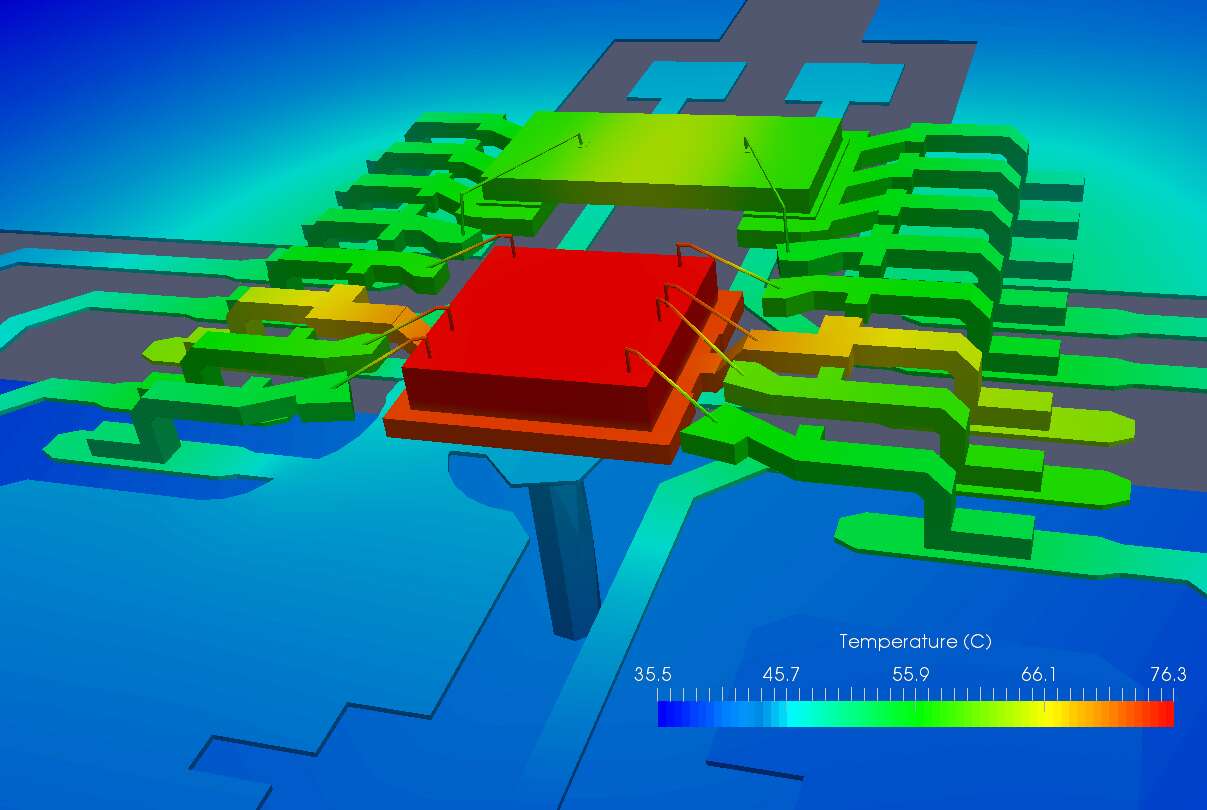The Importance of Thermal Management for Power Devices
Article By : M. Di Paolo Emilio

The Cadence Celsius Thermal Solver is the first complete electric-thermal co-simulation solution for the entire hierarchy of electronic systems, from integrated circuits to physical containers.
Understanding the thermal performance of integrated circuits, whether they are microcontrollers, FPGAs, or processors, has always been essential to avoid the overheating that can cause circuit malfunctions. The miniaturization of electronic systems and the diffusion of components that generate a lot of heat, such as LEDs, make the role of thermal analysis more and more important as a tool to guarantee the good functioning and reliability of products.
Unfortunately, however, the electronics industry does not yet seem to be fully prepared for this new challenge: in fact, component manufacturers often provide very scarce information on the thermal behavior of their devices, sometimes limiting themselves to the simple fact of dissipation overall expressed in Watts. In all this, software solutions allow solving design problems at a thermal level to improve performance.
Based on an architecture tested with high parallelism that offers up to 10 times faster performance than previous generation solutions without sacrificing precision, the Cadence Celsius Thermal Solver integrates with the Cadence implementation platforms for ICs, packages, and PCBs. This allows system analysis to be performed to detect and mitigate thermal problems early in the process. Cadence says its Celsius Thermal Solver is the first complete electric-thermal co-simulation solution for the entire hierarchy of electronic systems, from integrated circuits to physical containers.
Thermal performance
Companies that use 3D packages in particular face enormous thermal challenges that might not otherwise be identified until late in final stages of the design phase, when it’s most expensive to make changes.
That makes thermal management essential during package selection to ensure high product reliability. Good thermal evaluation requires a combination of analytical calculations, empirical analysis, and thermal modeling. The problem is to determine if the integrated circuit in question is reliable at high temperatures.
The relation that binds temperature over time is derived from two main laws: the Newton cooling law and the non-latent energy conservation law. The first can be defined as follows:

Where TB is the body temperature, TA the ambient temperature, and KA a proportionality constant. The following equation gives the second law:

Where P is the power applied to the body, m the mass, and c the specific capacity. Newton’s law states that a body’s rate of heat loss is proportional to the temperature difference between the body and the environment. Combining these two equations, we obtain the following relation:

Thermal resistance is the main factor to be analyzed. The calculation is carried out in relation to thermal equilibrium, i.e., when:

Developing the function, we obtain the following relationship:

Where

is the thermal resistance between the object and the environment. The problem is to determine whether the integrated circuit in question is reliable at high temperatures. Without a particular method of analysis, it is impossible to offer a reliable answer. In DC mode operation, very often, some parameters must be analyzed, such as θJA thermal resistance and θJC junction temperature. The first parameter can be defined as the inverse of thermal conductance and determines the heat insulation property of a textile material. The second one, the junction temperature, is an important factor in the semiconductor and is directly related to power dissipation.
Thermal tools
The main techniques used for correct thermal management can be summarized as follows: composite materials that are usually main heat exchangers in a thermal management group (heat sinks); design, modelling and analysis tools that engineers and system designers use for testing, design, and analysis of thermal component productivity; substrate materials for packaging electronics.
Design software allows performing a thermal analysis through models and computational fluid dynamics for the management of airflow and temperature of components and various joints.
Combining finite element analysis (FEA) techniques for solid structures and computational fluid dynamics (CFD) for fluids, the solution presented by Cadence allows a complete evaluation of the system using a single instrument. When using Celsius Thermal Solver with Voltus IC Power Integrity and Sigrity technologies for PCB and IC packaging, design teams can combine electrical and thermal analysis and simulate current and heat flow, obtaining more accurate system-level thermal simulation than previous generation tools.
The trend in the thermal management sector aligns with developments in semiconductors, microprocessors, and computer technology. Development is the result of a synergy of constantly engineered solutions to manage excess heat in today’s electronic systems.
“Electrical performance, as we know, depends on the thermal profile. For example, electrical resistance, and power leakage within a device depend on the temperature. And temperature will also affect functionality and reliability of the device. On the other hand, the thermal profile will depend on electrical performance. The Joule heating would introduce additional heat source in the system, and a poor design may create a high current surge within the traces, introducing an adverse hotspot. For a better design, it’s important to consider these parameters simultaneously, and this is the essence of our solver,” said CT Kao, product management director in the Multi-Domain System Analysis Business Unit at Cadence.
The search for high speed and high performance in the electronics industry has led, for example, to the development of three-dimensional (3D) integrated circuits. The 3D technology allows vertical interconnections of the components of a microprocessor in a package; this translates into a multi-chip module (MCM), system-in-package (SiP), system-on-package (SOP) and package-on-package configurations (POP). 3D processors are compact and have shorter interconnections. This improves memory access bandwidth and reduces interconnection at the dissipation energy level. Furthermore, it integrates hetero-gene technologies in a single package to reduce time-to-market and make it economically viable.
However, 3D induces high thermal resistance, and the uneven spatial and temporal power dissipation causes thermal problems such as hotspots, high-temperature gradients, and thermal stresses; this requires thermal solutions suitable for 3D microprocessors that include liquid-cooled microchannel heatsinks (MHS), TSV (Through Silicon Via), thermal material interfaces (TIM) and air-cooled heat sinks (AHS). Through-Silicon Vias (TSVs) are considered an effective means of reducing the temperature of 3D ICs and represent a high-performance interconnection technique, used for the first time in CMOS image sensors.
Celsius Thermal Solver performs static (stationary) and dynamic (transient) electrothermal simulations based on the actual flow of electrical energy in advanced 3D structures, offering maximum visibility on the behavior of the real system.
“We have identified three types of approaches to solving the thermal analysis challenges engineers encounter in a design: IC-centric, package and PCB centric, and system-centric. The IC-centric approach can conduct electrical-thermal co-simulation for complex chip-level structures including 3D-IC, die-to-die bonding, and through-silicon via. The power input may be user-specified or imported from a chip design tool that generates accurate power profiling on chips. For package and PCB-centric applications, we integrate finite element analysis and CFD to do both transient and steady-state analyses for true 3D structures and 2D layered structures. For the larger system-centric approach, again integration of finite element analysis and CFD is used to perform transient and steady-state analyses. We can also provide detailed simulation results to the packages or boards with the system based on the obtained system solution,” said Kao.
By allowing electronic design teams to analyze thermal problems early and to share the properties of thermal analysis, Celsius Thermal Solver reduces changes in the design phase and enables new evaluations and design insights impossible with traditional solutions. Furthermore, Celsius Thermal Solver accurately simulates large systems with a level of detail that allows the evaluation of any element of interest, providing the first solution capable of modeling both small structures such as an IC (with its power distribution) as large structures as a chassis (figure 1).

Figure 1: A temperature profile of 3D structures inside a package with metal interconnects, as generated by the Cadence Celsius Thermal Solver [Source: Cadence]
Thermal management lays the foundation for proper heat control, which could limit the performance of chips and other microelectronic components, reducing reliability in terms of both cost and the environment. Due to the increasingly widespread diffusion of microelectronics and the increase in the need for reliability in increasingly complex situations, thermal management has become very important in industrial sectors such as LED lighting. Improving thermal management with efficient analysis ensures good heat dissipation for electronic devices with increasing processing power and increasingly compact.